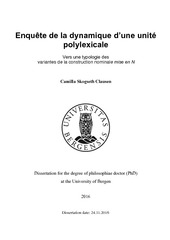| dc.description.abstract | In this study I have examined the French nominal multi-word unit mise en N and its many variants in a dynamic perspective on the basis of data collected from French language online newspapers between 2006 and 2007. In its most general sense, mise en N means ‘the action of putting somewhere, or the result of this action’ and is closely related to the verb mettre and the multi-word verb construction mettre en N (‘to put’/’to put somewhere’). It is a common and productive lexical form used in specialised as well as in general language. As an old lexical construction stretching back to Latin through Middle and Old French, it has a wide range of semantic content and features, and can be interpreted in different ways. However, existing studies of mise en N often consider its variants either as fixed expressions or as intrinsically belonging to the verb category. The objective of this study was to show that the scope of mise en N is much wider than this and that its variation can be seen as a result of the dynamic properties inherent to the construction that mise en N represent. To do this, the construction was studied from a nominal perspective as a proper lexical unit, where its variants were considered as multi-word nouns denoting an action; and, due to its many variants, it was also studied through an approach which included dynamic or unstable linguistic features, by considering mise en N as a nominal multi-word construction. therefore adopted a multi-methodological approach where 247 variants of the mise en N construction were studied in a dynamic corpus of data derived from online newspapers through the linguistic search engine GlossaNet. The variants were analysed in different perspectives (semantic content, morphosyntactic properties, frequency of use) and various linguistic and lexicographic sources (traditional dictionaries, online and dynamic dictionaries, term bases, the Web) were used to complement and evaluate the corpus findings. The analysis was based on a set of morphosyntactic, morphological and semantic evaluation criteria, and was systematised in an analyse table inspired by the lexicon grammar model developed by Maurice Gross (1975). Our analyses resulted in 271 identified mise en N variants, that is variants identified with a specific meaning and set of properties and thus provided with an individual entry in the table. Our findings show that mise en N can be seen as having a double lexical status: mise en N as a fixed multi-word expression (unité figée); and mise en N as a fixed multi-word construction (construction figée). As a fixed expression, a mise en N variant has become a part of the lexicon as a regular lexical unit, with a fixed form and meaning. The fixed mise en N variants were grouped in a separate category labeled locutions figées (LF). As a fixed construction, I consider mise en N as a lexical pattern that can be used to create other variants, and that can perhaps also explain its continuous variation and productivity. In addition it can be considered to have a more functional role which might indicate an ongoing grammaticalisation process. The analyses identified four types of mise en N constructions: type A where mise en N is linked to the verb mettre in a locative sense (‘to put (something) somewhere’), ex. mise en pots; type B including mise en N variants linked to the causative verbs rendre/faire devenir (‘to make (someone/something) become’), ex. mise en accessibilité; type C including variants linked to the factitive verb faire (‘to make (someone/something) do’), ex. mise en circulation ; type D including a heterogenous group of mise en N that can be linked to a variety of verbs, ex. mise en emploi, mise en peinture, mise en tourisme. The types can also be characterised by the type of action they imply. Type A and B would have an affected object with a passive function, the affected objet of type C would be active; however, type D can be said to denote the sense of action more generally, i.e. providing the sense of action and of duration to something that is lacking it, or where the sense of action is ambiguous, as in the case of action nouns that can be interpreted as an process, an event or as the result of the action. | en_US |
